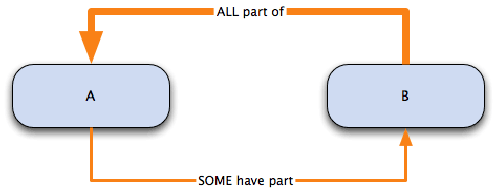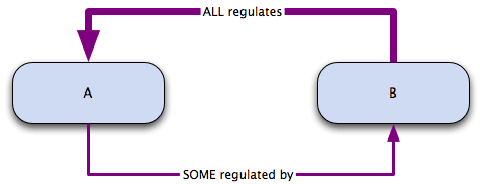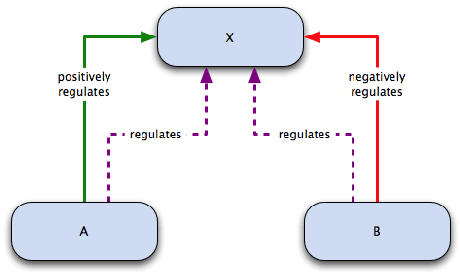This diagram would be interpreted as follows:
- A is a B
- B is part of C
- we can infer that A is part of C
The is a relation
The is a relation in GO is very simple: if we say A is a B, we mean that node A is a subtype of node B. For example, mitotic cell cycle is a cell cycle, or lyase activity is a catalytic activity.
It should be noted that is a does not mean ‘is an instance of’. An ‘instance’, ontologically speaking, is a specific example of something; e.g. a cat is a mammal, but Garfield is an instance of a cat, rather than a subtype of cat. GO, like most ontologies, does not use instances, and the terms in GO represent a class of entities or phenomena, rather than specific manifestations thereof. However, if we know that cat is a mammal, we can say that every instance of cat is a mammal.
The part of relationship
The relation part of is used to represent part-whole relationships in the Gene Ontology. part of has a specific meaning in GO, and a part of relation would only be added between A and B if B is necessarily part of A: wherever B exists, it is as part of A, and the presence of the B implies the presence of A. However, given the occurrence of A, we cannot say for certain that B exists.
The has part relationship
The logical complement to the part of relation is has part, which represents a part-whole relationship from the perspective of the parent. As with part of, the GO relation has part is only used in cases where A always has B as a part, i.e. where A necessarily has part B. If A exists, B will always exist; however, if B exists, we cannot say for certain that A exists.
The regulates relation
Another common relationship in the Gene Ontology is that where one process directly affects the manifestation of another process or quality, i.e. the former regulates the latter. The target of the regulation may be another process—for example, regulation of a pathway or an enzymatic reaction—or it may be a quality, such as cell size or pH. Analogously to part of, this relation is used specifically to mean necessarily regulates: if both A and B are present, B always regulates A, but A may not always be regulated by B.
The regulates relation has two sub-relations, positively regulates and negatively regulates, to represent these more specific forms of regulation. This means that if A positively regulates X, it is true to say that A regulates X. The following diagram illustrates this relationship:
from: http://www.geneontology.org/GO.ontology-ext.relations.shtml





